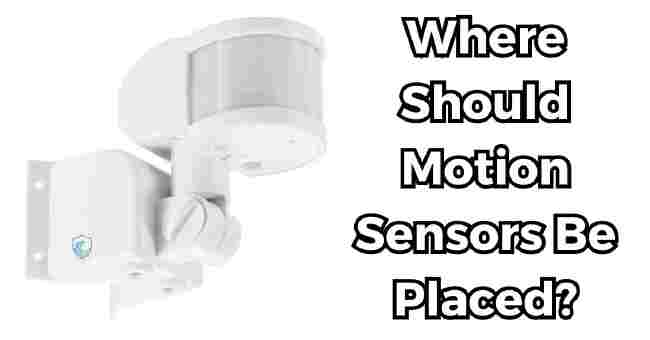Table of Contents
Where should motion sensors be placed in your home for maximum security? This is a question I’ve continually refined the answer to over my 15 years installing home alarm systems.
When our family home was robbed after first moving to the city, I realized our security gaps – leading me to become an amateur detection expert leveraging the latest technologies.
Through my trial and error with strategically testing motion sensors in key interior and exterior spots, I’m now confident every nook of our property enjoys 24/7 monitoring.
I’ll share my methodology for optimal motion detector placement so you can protect your valuables too.
What Are Motion Sensors and Why Do You Need Them?
Motion sensors, sometimes called motion detectors, are security devices that sense movement in a specific area and trigger an alarm signal.
The most common type rely on passive infrared (PIR) technology that detects body heat from people or animals moving within its field of view.
Here are some of the main benefits motion sensors provide as part of your home burglar alarm system:
- Earlier intrusion detection – Motion sensors can spot an intruder immediately upon entry into your home, while your main alarm sensors on doors/windows only activate once opened.
Those vital extra seconds of warning time allow the alarm to be triggered faster and give more chance for action or escape. - Area monitoring – Detectors placed in specific rooms can track movement only in that designated space, giving extra security to high priority areas like master bedrooms or home offices.
- Minimizing false alarms – With precise motion-based triggers, false alarms from environmental factors are reduced compared to alarms on doors and windows which can be affected by weather, bugs, pets etc.
- Smart home automation – Many motion sensors today integrate with platforms like Alexa or Google Home for voice control, customized notifications and automatic lighting adjustments triggered by movement.
Key Factors for Placement Success
The strategic placement of motion sensors is crucial to maximize their security benefits.
Here are the main factors I consider when determining the optimal positioning:
- Detection coverage – Sensors should monitor your most vulnerable entry points, as well as high-traffic interior areas near entrances. Consider an overlapping zone approach to eliminate blind spots across key locations.
- Mounting specifications – Proper mounting height, angle and field of view tuning is vital to meet coverage needs and avoid false alarms from non-threatening motion.
- Sensor capabilities – Factors like detection technology, range, battery life, wireless/wired options must align with your placement goals. Outdoor rated models may be needed for exterior locations.
With those elements in mind, let’s explore the best places to install motion detectors both inside and outside your home.
Where Should Motion Sensors Be Placed on the Exterior?
Outdoor motion sensors are designed to withstand weather elements and typically have a longer-range detection distance.
Here are the 3 perfect spots for outdoor protection:
- Driveways, Pathways and Yards
- Front, Side and Back Doors
- Ground Floor Windows and Patios
Driveways, Pathways and Yards
Install weatherproof motion-sensing floodlights or standalone detectors:
- Along driveways aimed at the entry point to your property
- Facing walking paths leading to back or side doors
- On posts scattered throughout your backyard to cover the full grounds
These provide the earliest possible warning by spotting intruders the moment they step onto your property.
Front, Side and Back Doors
Aim motion sensors:
- Above garage doors facing the approach
- At the front door aimed parallel across the entryway
- Outside secondary entrances like basement doors
Covering all exterior doors ensures no blind spots around the perimeter.
Ground Floor Windows and Patios
Position motion detectors:
- Under the eaves across large window expanses
- Facing patio doors to catch sideways movement
- On porch ceilings monitoring patio spaces
Windows and patios are highly vulnerable entry points a burglar may try after doors.
Where Should Motion Sensors Be Placed Indoors?
Now let’s explore optimal room-by-room motion sensor positioning inside your home:
- Entryways and Foyers
- Hallways and Staircases
- Living Rooms and Main Floor Common Areas
- Bedrooms and Offices
Entryways and Foyers
Place motion sensors:
- In corners of front & back foyer spaces aimed toward the area of movement
- Facing inward from the ceiling above internal garage doors
- Just inside exterior doors aimed diagonally into the space
Foyers see the most foot traffic from family and guests, so intruders would likely pass through here.
Hallways and Staircases
Install motion detectors:
- At hallway intersections facing down their length
- On second floor stairwell walls aimed at the landing
- Halfway up staircases facing top and bottom
Hallways and stairs that access upper floors should be monitored closely.
Living Rooms and Main Floor Common Areas
Position motion sensors:
- In living room corners aimed where intruders would walk
- Facing inward on vaulted ceilings to maximize coverage
- Monitoring open concept spaces near front/back entrances
These busy common spaces connecting to access points need robust coverage.
Bedrooms and Offices
Place motion detectors:
- Inside master bedrooms facing the entry doorway
- Monitoring the space between dressers and beds
- In home office corners covering room entrances
Bedrooms with valuables and home offices with sensitive documents are key monitoring zones.
Pro Tips for Mounting Motion Sensors
Beyond location selection, the specifics of how you mount a motion sensor impacts its detection coverage.
Follow these best practices when physically installing your detectors:
| Height | 7-9 feet overlooking the area for optimal range |
|---|---|
| Angle | Tilted slightly downward, parallel to movement |
| Field of View | 90-120° cone shaped detection area |
- Place high on walls facing openings that intruders would pass through
- Angle lens to avoid blind spots and false alarms from windows
- Adjust sensor sensitivity to only detect human sized heat signatures
I recommend a “walk test” by having a partner move in mock intruder routes as you confirm clear motion detection. This verifies full visibility coverage.
Choosing the Right Motion Sensor Technology
With your placement spots selected, now let’s explore a few key variables in the sensors models available to determine what fits your needs:
| Factor | Considerations |
|---|---|
| Type | Indoor, outdoor, wireless, wired |
| Detection Method | PIR, Microwave, Dual Tech combo |
| Power Source | Battery, hardwired electric |
| Smart capability | Alexa, Z-wave, HomeKit compatible |
- Indoor vs outdoor rating based on locations needed
- PIR solid go-to tech; microwave good for harsh climates
- Hardwired models provide unlimited power but limit flexibility
- Smart sensors enable voice control, custom automations
I always recommend going with a reputable brand you recognize providing reliable performance suitable for your climate and placement goals.
Integrating Motion Sensors With Alarm Systems
The full value of motion sensors comes from seamlessly integrating them with your whole-home burglar alarm system.
This unlocks benefits like:
- Professional monitoring – Alarm companies can dispatch police faster than DIY smart home setups
- Instant notifications – Get SMS and push alerts of motion events triggered for quick action
- Smart response – Connect to Alexa Guard or Apple HomeKit for voice announcements when sensors activate
I suggest consulting a professional home security installer if you currently lack an alarm system.
They can perform a full site analysis to determine ideal motion detector placements and install monitored equipment.
Going Beyond Motion Sensors in Your Security Strategy
While motion sensors are extremely useful for intrusion detection, I always recommend a layered security approach with multiple complementary technologies:
- IP security cameras – High-def video recording and forensic analysis to verify real threats
- Door/window sensors – Perimeter breach detection at entry points
- Environmental monitors – Fire, flood and temperature sensors to catch hazards
- Panic pendants – Wearable buttons for discreet duress signaling
This “defense in depth” ensures all physical and contextual layers work together to provide 24/7 protection with redundancy to catch issues other sensors may miss.
What Are The Best Types Of Motion Sensors For Home Security?
There are several types of motion sensors available for home security, each with its unique capabilities.
The most common type of motion sensor for home security is the Passive Infrared (PIR) sensor, which detects body heat by looking for changes in temperature. PIR sensors are reliable and cost-effective.
Other types of motion sensors include microwave sensors, ultrasonic sensors, dual technology sensors, and image sensors.
Microwave sensors are ideal for outdoor use, while ultrasonic sensors are best for indoor use.
Dual technology sensors combine two or more technologies to reduce false alarms, while image sensors capture images of intruders.
When choosing a motion sensor, consider the layout of your home, the type of sensor, and the level of security you need. It is also essential to follow the manufacturer’s guidelines and recommendations for the most effective placement.
FAQs
How Far Can A Motion Sensor Detect?
When selecting motion sensors, take note of the listed “detection range” to understand maximum coverage distances.
For most indoor passive infrared (PIR) models, the ranges fall between 20-30 feet. So in a typical room, that can cover entryways and good portion of space.
Outdoor motion sensor lights can reach up to 70 feet thanks to greater durability and powered specs.
Units using microwave and dual technology often extend even farther – from 50 feet beyond.
I always recommend mapping out your likely intruder approach paths, then using multiple overlapping sensors to eliminate gaps along that whole route.
With 3 strategically aimed motion detectors each at 30 feet, you can essentially cover a 90 foot path of property access points without a blind spot.
Bottom line is while a single motion sensor has limited range, combining several expands that bubble of security monitoring.
Do Motion Sensor Lights Use More Electricity?
This is a common concern – having a bright LED floodlight activated by motion detection seems like it may rack up the energy bills.
However when you crunch the numbers, a typical 50-Watt outdoor security light paired with a motion sensor uses far less kWh than an always-on fixture.
For example, if a porch light is on 12 hours overnight, that totals 600 Watt-hours (50W * 12hrs) per day.
A motion detector light would maybe tally 2-3 minutes of activation from occasional movement detection…so around 0.5 Watt-hours per day.
Over a month the always-on light would use 18,000 Wh compared to just 15 Wh with a detector – drastic savings.
So motion-triggered operation really cuts unnecessary power waste.
How Far Does A Motion Sensor Light Reach?
While the motion detection range refers to the sensor’s ability to pick up movement within a coverage zone, light “reach” indicates how far the illumination itself extends once triggered.
Most security floodlights paired with passive infrared sensors provide between 2000-3000 lumens.
For context, an ordinary 60W porch bulb emits around 800 lumens. So at over triple the brightness, a 3000 lumen motion floodlight can easily cast light 25-50 feet in most directions!
That baths an average sized yard, driveway or entryway in bright near-daytime visibility.
The precise distance depends on surrounding structures and landscapes that may obstruct.
But you can count on a wide glow from quality LED motion security lights to reveal objects clearly at 40+ feet when sensors spot activity.
Position the light high atop a wall or eave and the illumination reach grows even farther. This ensures clear views of detected motion triggers through the night.
What Is The Ideal Mounting Height For Motion Sensors?
The recommended mounting height for most motion detectors is between 7 to 9 feet above the floor.
This high positioning allows the sensor to look down and cover more floor space at a wider, more consistent angle without obstructions.
Aim for the lens to tilt ever so slightly downward, facing the central area where an intruder would typically walk.
Corner installation often works well to blend into room ceilings while still providing a broad diagonal detection pattern across the space.
Should Motion Sensors Face Walls Or Openings?
Generally, you’ll want to position motion sensors facing openings through which an intruder would enter, rather than flat up against a wall.
Angling the detector lens toward doorways or across room openings allows a sensor to view the area with highest likelihood of catching movement.
This prevents blind spots versus a wall-facing detector only viewing those moving perpendicular across its field.
Of course, positioning sensors in room corners can often face both the wall and opening for a nice blend.
But maximize visibility of expected intruder approach paths in your positioning strategies.
What Causes False Motion Sensor Alarms?
False alarms are the nemesis of smooth-running motion sensor operation. These false triggers most often result from environmental conditions rather than real threats:
- Sunlight – Direct rays entering detection zones
- Drafts from HVAC vents – Hot or cold blowing air
- Windows – Trees moving, curtains blowing
- Insects/spiders entering sensor field of view
- Pets wandering within coverage area
Proper placement to account for these conditions, along with adjusting sensor sensitivity and range, will minimize disruptive false signals.
Confine pets, cover vents, test different mounting locations to reduce non-intruder motion detections.
How Can I Determine Motion Sensor Coverage Testing?
Verifying where motion sensors reliably detect movement, free of blind spots, is crucial for proper intrusion protection.
The best approach is to conduct structured walk tests:
- Set the alarm system to test mode with activated sensors
- Have a family member walk possible intruder paths
- Observe alarm panel indicators when sensors trigger
- Note zones with low or no responsiveness to refine placement
Aim to confirm robust activation from all expected intrusion directions. For large open floor plans, recruit multiple walkers to cover more simultaneous movement scenarios.
Be sure to save the testing mode for regular sensor checks and tuning during initial installation. Optimize positioning early before relying on the coverage daily.
Should I Camouflage Or Make Motion Sensors Visible?
Strategic visibility of security sensors can serve as a crime deterrent, making intruders hesitant about encroaching further.
However visible fixtures also allow burglars to potentially sabotage units. Often the best solution is to install sensors high and out of immediate sight lines for naturally obscured protection.
Blending colors to match interior décor also avoids drawing too much obvious attention.
Ultimately you want visible perimeter signs like window stickers for psychological deterrence, with sensors themselves discretely tucked away and out of reach.
Conclusion and Next Steps
I hope this overview gives you a detailed playbook on optimizing motion sensor placement as part of your comprehensive home security strategy.
The key is covering vulnerable exterior access points as well as high-traffic interior living spaces.
Be sure to follow mounting best practices and integrate with professional monitoring or smart home platforms.
Going beyond motion detection to create a robust layered security solution provides peace of mind knowing your family and home stays safe.
As next steps, I recommend:
- Reviewing motion sensor specs from trusted brands to match models to your needs
- Consulting a home security pro if lacking a system to add monitoring
- Testing potential mounting locations to confirm detection coverage
- Evaluating complementary sensors like IP cameras and door contacts to fill gaps
Please drop any lingering questions below, and consider subscribing for future home protection content




